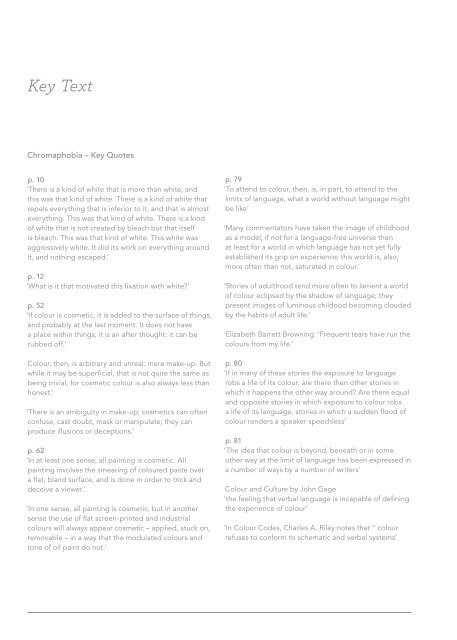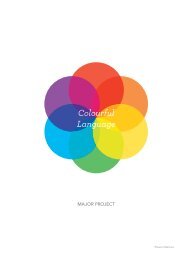Supporting Material Vol 1 - Colourful Language
Supporting Material Vol 1 - Colourful Language
Supporting Material Vol 1 - Colourful Language
Create successful ePaper yourself
Turn your PDF publications into a flip-book with our unique Google optimized e-Paper software.
Key Text<br />
Chromaphobia – Key Quotes<br />
p. 10<br />
‘There is a kind of white that is more than white, and<br />
this was that kind of white. There is a kind of white that<br />
repels everything that is inferior to it, and that is almost<br />
everything. This was that kind of white. There is a kind<br />
of white that is not created by bleach but that itself<br />
is bleach. This was that kind of white. This white was<br />
aggressively white. It did its work on everything around<br />
it, and nothing escaped.’<br />
p. 12<br />
‘What is it that motivated this fixation with white?’<br />
p. 52<br />
‘If colour is cosmetic, it is added to the surface of things,<br />
and probably at the last moment. It does not have<br />
a place within things; it is an after thought; it can be<br />
rubbed off.’<br />
Colour, then, is arbitrary and unreal: mere make-up. But<br />
while it may be superficial, that is not quite the same as<br />
being trivial, for cosmetic colour is also always less than<br />
honest.’<br />
‘There is an ambiguity in make-up; cosmetics can often<br />
confuse, cast doubt, mask or manipulate; they can<br />
produce illusions or deceptions.’<br />
p. 62<br />
‘In at least one sense, all painting is cosmetic. All<br />
painting involves the smearing of coloured paste over<br />
a flat, bland surface, and is done in order to trick and<br />
deceive a viewer.’<br />
‘In one sense, all painting is cosmetic, but in another<br />
sense the use of flat screen-printed and industrial<br />
colours will always appear cosmetic – applied, stuck on,<br />
removable – in a way that the modulated colours and<br />
tone of oil paint do not.’<br />
p. 79<br />
‘To attend to colour, then, is, in part, to attend to the<br />
limits of language, what a world without language might<br />
be like’<br />
‘Many commentators have taken the image of childhood<br />
as a model, if not for a language-free universe then<br />
at least for a world in which language has not yet fully<br />
established its grip on experience; this world is, also,<br />
more often than not, saturated in colour.’<br />
‘Stories of adulthood tend more often to lament a world<br />
of colour eclipsed by the shadow of language; they<br />
present images of luminous childood becoming clouded<br />
by the habits of adult life.’<br />
‘Elizabeth Barrett Browning: ‘Frequent tears have run the<br />
colours from my life.’<br />
p. 80<br />
‘If in many of these stories the exposure to language<br />
robs a life of its colour, are there then other stories in<br />
which it happens the other way around? Are there equal<br />
and opposite stories in which exposure to colour robs<br />
a life of its language, stories in which a sudden flood of<br />
colour renders a speaker speechless’<br />
p. 81<br />
‘The idea that colour is beyond, beneath or in some<br />
other way at the limit of language has been expressed in<br />
a number of ways by a number of writers’<br />
Colour and Culture by John Gage<br />
‘the feeling that verbal language is incapable of defining<br />
the experience of colour’<br />
‘In Colour Codes, Charles A. Riley notes that “ colour<br />
refuses to conform to schematic and verbal systems’



